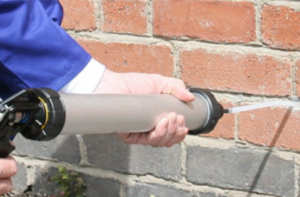Causes of dampness and mould can simply be caused by excess fluids of moisture that can’t escape. All homes, despite their age contain moisture within. Building materials should allow moisture to move downwards and spread out from wet to dry areas to prevent dampness build ups. Dampness can be avoided by increasing ventilation and increasing movement of naturally occuring moisture.
Causes Of Dampness
Causes of dampness and mould in your home may be triggered by many things, ranging from problems with your exterior walls to the plumbing in your house, below we have listed some of the main reasons for dampness.
External Walls
Dampness used to be more prevalent due to leakage rather than external walls. Older homes were designed to actually prevent dampness by reducing moisture build-up. All materials were permeable meaning that moisture was free to pass through walls, floors and ceilings, rather than being sealed in the house as condensation. Inappropriate building materials being used today stop the movement of moisture through walls, floors and ceilings, meaning that the moisture is trapped. Dampness is now more common in newer style homes causing many problems.
Gutters
Leaking gutters and undersized gutters can cause a great deal of hassle and if these problems aren’t resolved, these issues can result in dampness. When your gutter leaks, water will proceed to run down the outside of your home for short distances and splatter on the window sills. This process can happen more often if your gutters are undersized. This means that rainwater drips more regularly and this will speed up the erosion process and the speed of which water enters the walls. If this happens you should think about replacing your gutters with a bigger, more suitable size.
Downpipes
Previous cast-iron downpipes are known to easily rust and when they do it isn’t easily recognisable. You may see dampness or mould spreading from the pipes from a moisture build up. Other problems with downpipes are blockages that can occur when these old pipes have shard bends.
Plumbing
Intense damp patches can be caused by tiny drips coming from your internal plumbing. Although the escape of water is usually unnoticeable, it is often continuous and concentrated in the same spot causing dampness issues. The repeated introduction of moisture is too much and the moisture can’t escape quick enough, this then overloads into other areas. When having dampness near plumbing facilities make sure you check for new plumbing that drips at first use, corroded water pipes, failing waste pipes in older toilet rooms and damaged seals near all water facilities.
Holes in roofs
Having holes in your roof could be the root cause of your damp problem. If damp is coming through because of a hole in your roof this normally means that a tile/slate is missing or has slipped. This could also mean a worn thatch, or a broken tile or slate.
How do you prevent houses from getting damp?
Here at Treatex Wall Coatings we can prevent dampness and mould in your home to help combat the British climate.
Proof of damp penetration from within can occur with ageing solid wall construction. Undertaking an application of Treatex exterior weatherproof coating prevents any further ingress via the treated outdoor wall area. The application is applied under pressure by factory trained technicians and will help make sure that moisture is moving in the right direction and that no moisture is coming from outside, to inside. Once we have detected problem areas we make exterior walls good with a lime based cement render system and to make sure appearance is not affected, we blend in the render to fit in with the original appearance. Find more information on the ‘our process’ page.
Call Treatex Today
If you are interested in solving your damp problems and finding out more about causes of dampness, then call Treatex Damp Proof Wall Systems on 02031729421.

